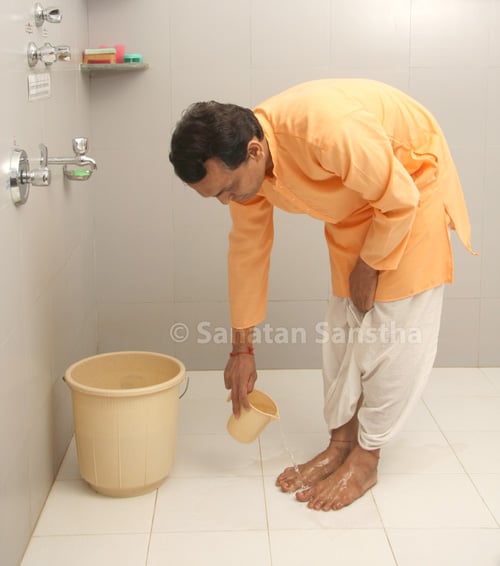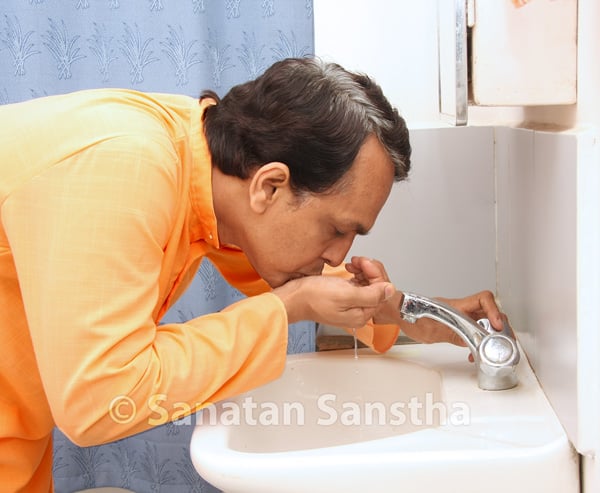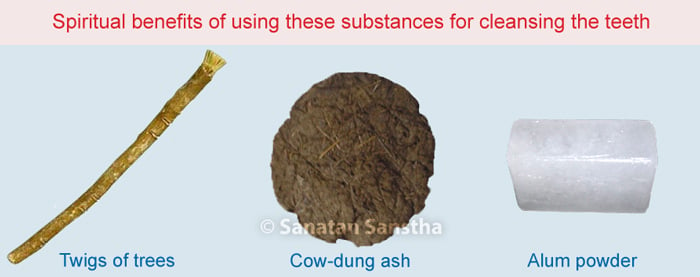Hindu personal hygiene practices associated with washing of hands & feet, rinsing of mouth and cleaning the teeth
-
Hands should be washed after urination or defecation with cow dung-ash or mud, till they are odour free. Alternatively, soap can also be used.
-
This should be followed by washing the feet and rinsing the mouth.
-
Then, water should be taken in cupped hands to wet the face and wash the eyes.
-
Conclude with Achaman (Sipping water from the cupped palm thrice, while uttering the first three of the twenty-four names of Shrivishnu and releasing the water into a plate from the palm while uttering the fourth name) and Vishnusmaran (Remembrance of Shrivishnu).
Underlying science in the above acts: Washing of hands and feet is associated with external cleansing, while rinsing of the mouth, Achaman and Vishnusmaraṇ are necessary for internal cleansing of the body.
We will now examine these acts one by one to understand them in depth.
1. Hindu personal hygiene practice related to cleaning the hands
Let us understand the spiritual reasoning behind rubbing hands with mud in order to eliminate the foul odour :
Mud has fragrant earth waves associated with the Pruthvi-tattva (Absolute Earth Principle) and Apa-tattva (Absolute Water Principle) in a dormant state.
The actions of urinating and defecating are also created from the excretory odour process related to the Pruthvi-tattva and Apa-tattva in the body. This relation stimulates the desire to urinate and discharge faeces. Hence, to get rid of these wasteful odour waves, the hand polluted in the process is washed by rubbing it with mud. The massage like touch of the mud results in destruction of the wasteful odour waves by the fragrant waves associated with the Pruthvi-tattva. This helps in reducing the contact of the wasteful odour waves with the physical body.
2.Hindu personal hygiene related to washing the feet
By washing the feet, the Raja-Tama predominant waves coming into contact with the feet while urinating or defecating are released into the water, and purify the physical body.
Feet should be washed while facing the west
प्राङ्मुखोऽन्नानि भुञ्जीत्तोच्चरेद्दक्षिणामुख: ।
उदङ्मुखो मूत्रं कुर्यात्प्रत्यक्पादावनेजनमिति ।। – Apastambadharmasutra, 1.11.31.1
Meaning: Have meals facing the east, defecate facing the south, urinate facing the north, and face the west when washing feet.
3. Hindu personal hygiene related to rinsing the Mouth
Rinsing the mouth upon waking up expels the tamasik (Tama-predominant) gases created in the body at night, which have accumulated in the night. Upon waking up, after washing the hands and the feet, bend forward and take a mouthful of water from the cupped right palm. Do this thrice, spitting up the water each time. Recitation of the shloka, ‘keâje«es Jemeles }#ceer: …’, before sipping the water from the cupped palms causes blending of divinity in the water, and since water is all-pervasive, it quickly absorbs these Divine waves. Rinsing the mouth with this water charged with divinity helps in expelling the tamasik gases that have accumulated in the mouth, due to activity in the body throughout the night.
4. Hindu personal hygiene cleaning the teeth
A. Praying to the substance used for cleaning the teeth
Before cleaning the teeth, pray to the substance used for cleaning the teeth, as given ahead.
आयुर्बलं यशो वर्च: प्रजा: पशून् वसूनि च ।
ब्रह्म प्रज्ञां च मेधां च त्वं नो देहि वनस्पते ।।
Meaning: Bless me with a long life, strength, success, radiance, subjects, and animals, wealth, Brahman (God Principle), intellect and the power to comprehend
(This is the great Hindu Dharma, one that teaches offering of gratitude towards a plant useful in cleansing the teeth, and thereby perceiving divinity in it)
B. Which substance should be used and which should be avoided in cleansing the teeth?
-
Use a twig of trees like neem , khair, karanj, audumbar (cluster fig tree) for cleansing the teeth.
Underlying science: Cleansing the teeth with a twig of neem, audumbar etc, disintegrates the Raja-Tama predominant waves on the teeth, facilitating the generation of pure gases in the mouth, which gradually spread in the voids within the body and provide these voids with energy to continue the day’s activities.
-
Use cow-dung ash made by burning dried cow-dung or powder of alum for cleansing the teeth.
Underlying science: Teeth are predominantly a blend of the Pruthvi-tattva and the Apa-tattva. Food collected in the spaces between the teeth during the process of eating, create Raja-Tama predominant foul odour over a period of time. This makes the atmosphere within the void of the mouth impure or polluted.
-
Alum: Fragrant gas having a momentum and associated with the friction related Tej-tattva (Absolute Fire Principle) is concealed in alum. Applying alum helps in concentration of both Raja-Tama predominant waves and waste gases in the teeth, in the void of the mouth. The concentrated atmosphere that is formed at the level of Tej, and to some extent, one that indicates the disintegration process of Raja-Tama predominant waves, gets washed away because of the rinsing of the mouth with water. Cow-dung ash prepared by burning cow-dung is more beneficial than alum.
C. To cleanse the teeth based on the tridosh (Three defects) and trigun (Three components)
Tridosh: Depending on whether Vata (Wind), Kapha (Phlegm) or Pitta (Bile) is the predominant factor of the constitution, use a twig, cow-dung ash and alum respectively.
Trigun : In terms of the principle, it is appropriate that sattvik, rajasik and tamasik jivas use a twig, cow-dung ash and alum respectively.
Reference: Sanatan Sanstha’s Holy Text ‘Daily conduct and science underlying its Acts’




